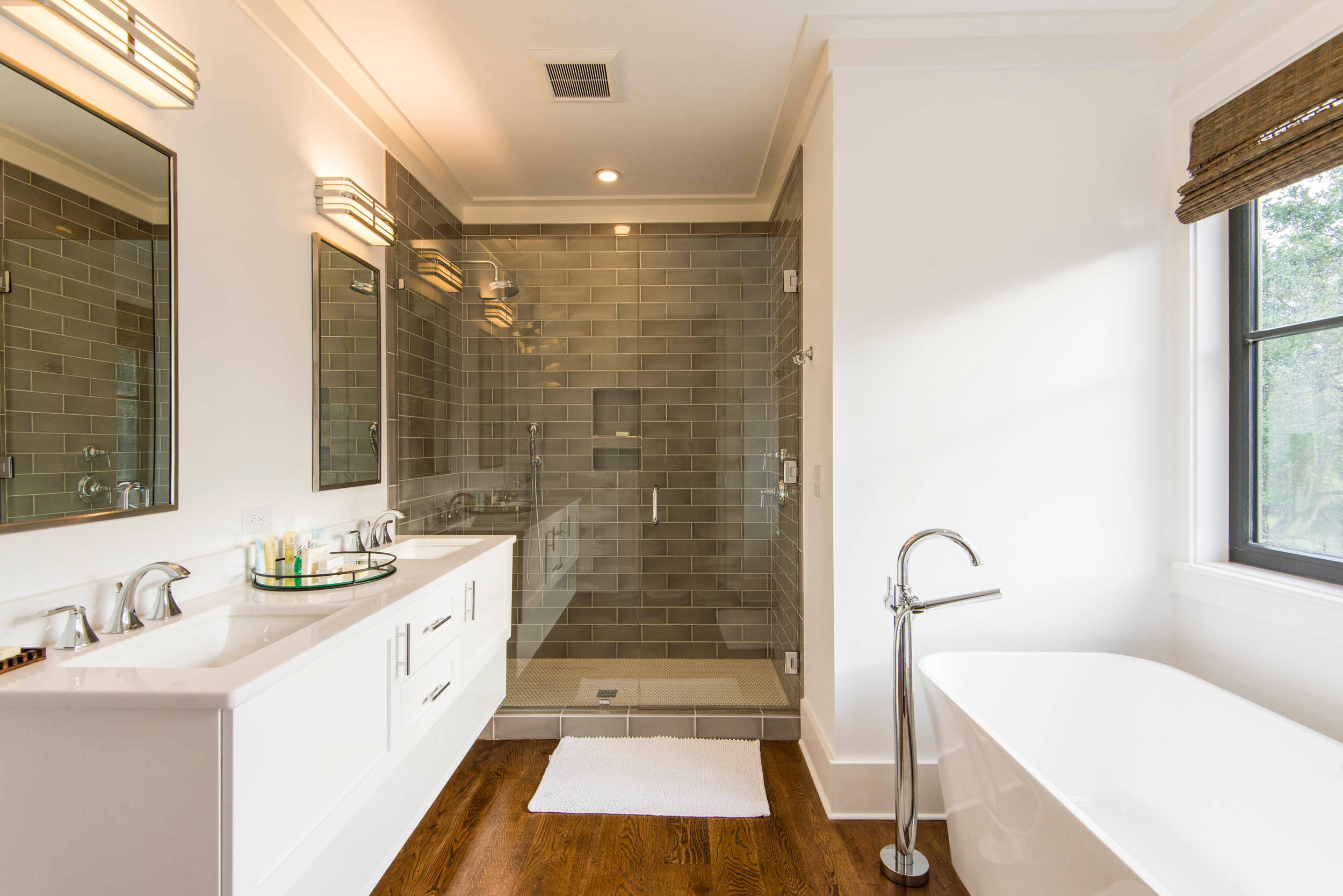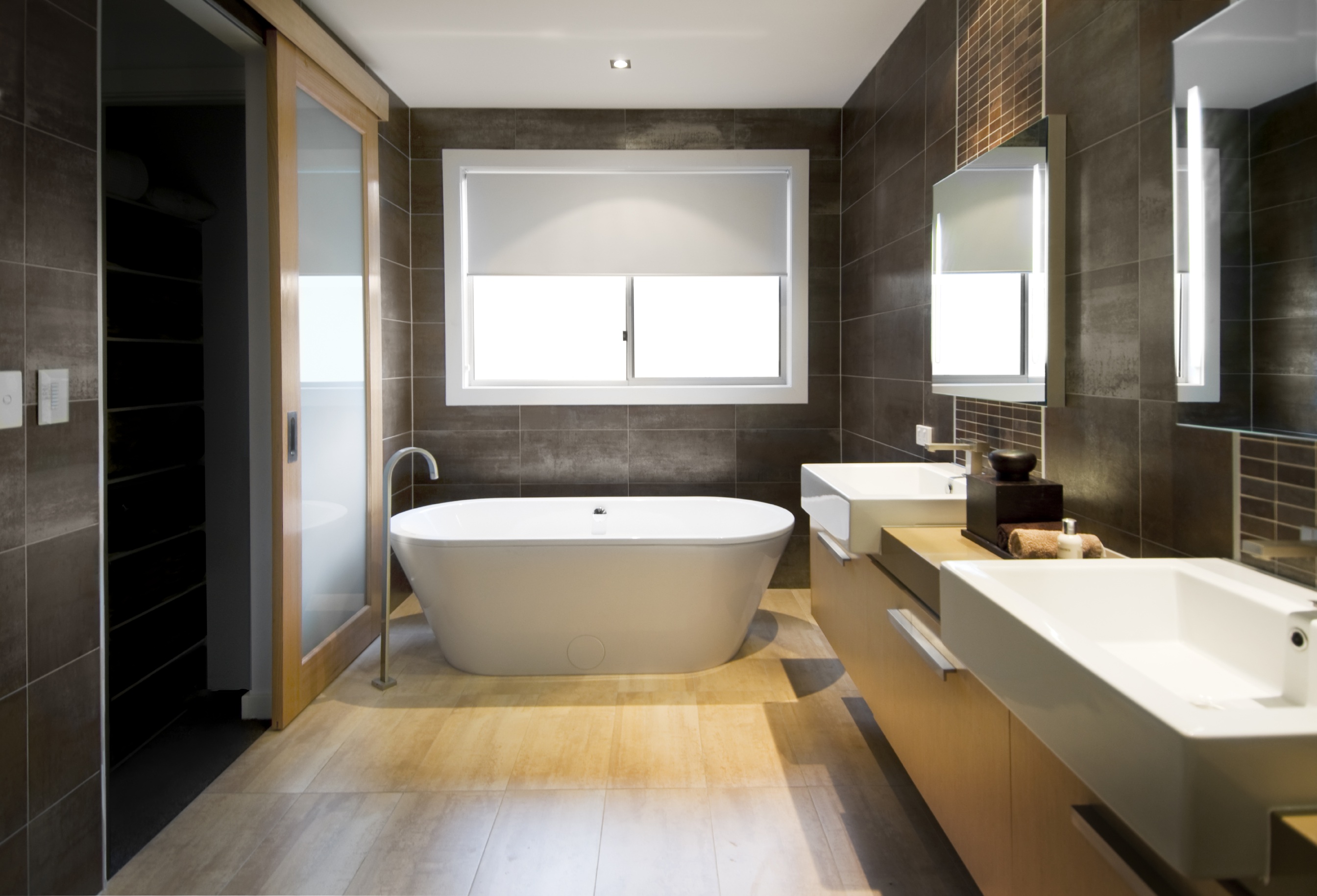Bathroom Design Ideas with Wood Floors: Wood Floor Bathroom Ideas

Wood floors are a popular choice for bathrooms because they are durable, water-resistant, and stylish. They can be used to create a variety of bathroom designs, from modern to farmhouse to traditional.
Using Wood Floors to Create Different Bathroom Styles
Wood floors can be used to create a variety of bathroom styles. Here are some examples:
- Modern: Modern bathrooms often feature sleek lines, minimalist designs, and neutral colors. Wood floors can complement this style by adding warmth and texture. Choose light-colored woods, such as maple or birch, for a clean and airy feel. You can also use dark-colored woods, such as walnut or ebony, to create a dramatic contrast.
- Farmhouse: Farmhouse bathrooms are known for their rustic charm and cozy atmosphere. Wood floors are a perfect fit for this style, especially if they have a distressed or weathered finish. Choose reclaimed wood or barn wood for a truly authentic look. You can also add rustic accents, such as a farmhouse sink or a vintage mirror.
- Traditional: Traditional bathrooms often feature ornate details, such as crown molding, wainscoting, and elaborate fixtures. Wood floors can complement this style by adding a touch of elegance. Choose dark-colored woods, such as cherry or mahogany, for a classic look. You can also use wood floors with a high-gloss finish to create a formal and sophisticated feel.
- Eclectic: Eclectic bathrooms are a mix of different styles and influences. Wood floors can be used to create a cohesive look by tying together different elements. Choose a wood floor that complements the dominant style in the bathroom, and then add accents that reflect other styles. For example, you could use a rustic wood floor in an eclectic bathroom that also features modern fixtures and a vintage vanity.
Using Wood Floors to Enhance Functionality and Flow
Wood floors can also be used to enhance the functionality and flow of a bathroom space. Here are some ideas:
- Create a Visual Connection: Wood floors can help to create a visual connection between different areas of a bathroom. For example, you could use the same wood floor throughout the entire bathroom, including the shower or tub area. This will make the space feel larger and more cohesive.
- Define Different Zones: Wood floors can be used to define different zones in a bathroom. For example, you could use a different color or pattern of wood floor in the shower or tub area to create a distinct space. This can be especially helpful in large bathrooms where you want to create separate areas for bathing, dressing, and grooming.
- Add Warmth and Comfort: Wood floors can add warmth and comfort to a bathroom. This is especially important in bathrooms that are located in colder climates. You can choose a wood floor with a soft, natural finish to create a cozy and inviting feel.
- Improve Durability and Water Resistance: Wood floors are a durable and water-resistant flooring option for bathrooms. They can withstand heavy foot traffic and spills, and they are easy to clean. When choosing wood floors for a bathroom, be sure to select a wood species that is known for its durability and water resistance. You should also seal the floors with a waterproof sealant to protect them from moisture damage.
Color and Finish Options for Wood Floors in Bathrooms

Choosing the right color and finish for your wood floors can significantly impact the overall ambiance of your bathroom. You can create a spa-like retreat, a modern minimalist space, or a cozy and inviting sanctuary, depending on your preference.
Color Options for Wood Floors in Bathrooms
The color of your wood floors plays a crucial role in setting the mood and atmosphere of your bathroom. Light colors tend to create a sense of spaciousness and brightness, while darker colors can make the space feel more intimate and cozy.
- Light Colors: Light wood floor colors, such as white oak, maple, and ash, can brighten up a small bathroom and make it feel more spacious. They reflect light, creating a sense of airiness and openness. These colors are particularly well-suited for modern or minimalist bathroom styles.
- Dark Colors: Dark wood floor colors, such as walnut, cherry, and mahogany, can add warmth and sophistication to a bathroom. They create a more intimate and cozy atmosphere, especially in larger bathrooms. These colors are ideal for traditional or rustic bathroom styles.
- Warm Colors: Warm wood floor colors, such as cherry, mahogany, and walnut, create a welcoming and inviting ambiance. They can add a touch of warmth and sophistication to any bathroom style.
- Cool Colors: Cool wood floor colors, such as ash, maple, and white oak, create a sense of calm and serenity. They can help to create a spa-like retreat in your bathroom. These colors are particularly well-suited for modern or minimalist bathroom styles.
Finish Options for Wood Floors in Bathrooms, Wood floor bathroom ideas
The finish you choose for your wood floors will impact their durability, appearance, and overall feel.
- Matte Finish: A matte finish provides a natural, understated look that can complement a variety of bathroom styles. It is less reflective than other finishes, creating a softer and more subtle appearance.
- Glossy Finish: A glossy finish adds a touch of shine and elegance to wood floors. It reflects light, making the space feel brighter and more spacious. However, glossy finishes can highlight imperfections in the wood and may require more maintenance.
- Satin Finish: A satin finish offers a balance between a matte and glossy finish. It provides a subtle sheen that enhances the natural beauty of the wood without being overly reflective. Satin finishes are a popular choice for bathrooms as they offer a good balance of durability and aesthetics.
Wood Floor Colors and Finishes for Different Bathroom Styles
Here is a table outlining wood floor colors and finishes that complement different bathroom styles:
| Bathroom Style | Wood Floor Color | Finish |
|---|---|---|
| Modern | White Oak | Matte |
| Minimalist | Ash | Satin |
| Traditional | Cherry | Glossy |
| Rustic | Walnut | Matte |
| Contemporary | Maple | Satin |
Selecting the Right Color and Finish
When selecting the right color and finish for your wood floors, consider the following factors:
- Bathroom Size: Light colors can make a small bathroom feel larger, while darker colors can make a large bathroom feel more intimate.
- Natural Light: If your bathroom has limited natural light, choose a light color with a satin or glossy finish to reflect light and brighten the space.
- Bathroom Style: Choose colors and finishes that complement your bathroom’s overall style.
- Personal Preference: Ultimately, the best color and finish for your wood floors is the one that you love the most.
Practical Considerations for Wood Floors in Bathrooms
Bathrooms are often considered a challenging environment for wood flooring due to the presence of moisture and water. However, with careful planning and the right materials, wood floors can be a beautiful and durable addition to your bathroom.
Water Resistance and Durability
Water resistance and durability are paramount for wood floors in bathrooms. Unlike other areas of the house, bathroom floors are constantly exposed to moisture, splashes, and even spills. This exposure can lead to warping, rotting, and mold growth if the wood is not properly protected.
Sealant and Finishing Techniques
Sealants and finishing techniques play a crucial role in safeguarding wood floors from moisture damage. A high-quality sealant acts as a barrier, preventing water from penetrating the wood’s surface.
- Polyurethane is a popular choice for bathroom floors due to its durability and resistance to water and scratches.
- Epoxy is another excellent option, known for its extreme durability and resistance to moisture and chemicals.
- Oil-based finishes can also be used, but they require more frequent reapplication to maintain their protective properties.
Maintenance and Cleaning
Maintaining and cleaning wood floors in a bathroom is essential to preserve their beauty and longevity.
- Regular sweeping or vacuuming removes dust and debris that can scratch the surface.
- Damp mopping with a mild cleaner specifically designed for wood floors is recommended for routine cleaning.
- Avoid using harsh chemicals, abrasive cleaners, or excessive amounts of water, as these can damage the finish and the wood itself.
